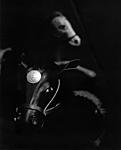1. I usually meter average caucasian skin tones at Zone V or VI. It shouldn't be much different regardless of the light source, it's the amount of exposure that the film receives that is important.
2. It's not possible to predict what shutter and aperture settings to expect, given that the intensity of artificial lights and distance from the subject will vary greatly. If your main light source is the setting sun, streetlights, lamps, candles or otherwise, that will be the main determinant of your exposure settings, along with your film speed. The rule of "Sunny-16" for daylight exposures is only possible given that the luminance of the sun at certain latitudes and times of day is a known factor. Correct exposure becomes very difficult to predict with artificial light sources and at night, until you start taking meter readings of your subject.
3. You can add light to the subject without having it look too artificial or resorting to strobe flash. This may let you use shorter shutter speeds and/or smaller apertures. It's a big can of worms and there's lots of options available.
4. Exposure compensation for bellows extension is always a factor to consider. As you focus on a closer subject, you need to extend the bellows to get a sharp image. This means the lens is further from the film and the intensity of the light hitting the film is fainter. This is where a tape measure comes in handy. First set up your camera in daytime and focus on a distant object more than a few hundred feet away. Measure the distance from the lens board to your film plane and this will be your infinity focus distance for this lens. It should be approximately equal to the focal length of the lens, say 180mm (or 7"). To focus on objects that are closer, you'll need to extend the bellows. A general rule I use is to add one stop exposure for every 50% of bellows extension. So if my 180mm lens has been focused on a close subject and it measures 270mm from the film (an extra 50% or 90mm), I would add an additional stop of exposure (either slower shutter speed or larger aperture). If the subject was not so close and the bellows measured 225mm (an extra 25% or 45mm) then add only 1/2 stop exposure.
Low-light exposures with large format can be tricky. You're generally using slower shutter speeds and most lenses are not very fast. Your shutter speeds may be very slow so your subject will need to hold still. Mistakes will be more expensive per shot also. Personally, I'd try this with 35mm or medium format as the lenses are faster and the cost per shot is much less.
Here's an example of a shot I took in low light and while not really a people portrait, the metering situation was similar to what you are describing.
- Interior shot, both carousel horses illuminated by spotlights from above.
- The shadows were very dark so I spot metered off the horses' heads only. With the black one I was careful to avoid the silver headpiece (will influence the meter), and put it at about Zone III. With the lighter background horse I metered at about Zone VI.
- This was taken on 35mm, handheld but braced against a chair, and I think the exposure was about 1/8 sec at F:2 on ISO 400 film. The negative looks underexposed, but it printed very easily in the darkroom.







 Reply With Quote
Reply With Quote

Bookmarks